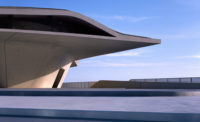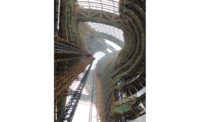When the news of Zaha Hadid’s death hit on the morning of March 31st, the shock of its suddenness, fueled by the power of social media, set off a tidal wave of emotion that swept across the architecture world. Hadid was known by everyone—if she was not quite a household name, she came close—and, regardless of what you thought of her work, she was a presence like no other. Born in Baghdad in 1950, she was, at 65, barely into middle age by architecture standards. Her 400-person office in London, where she had lived since 1972, when she arrived at the Architectural Association to study under Rem Koolhaas, was busier than it had ever been. There seemed every reason to believe that she had years, even decades, of fruitful practice ahead of her. More than any of her peers, she had succeeded in pulling off an architectural trifecta: her work was intellectually ambitious enough to excite critics and students; it was practical and buildable enough to engage institutional and, increasingly, commercial clients; and it was, almost always, unforgettable.
That last phrase could describe Hadid herself, of course, and it often was hard to separate her larger-than-life persona from her striking work. Who could forget Hadid, sweeping into a room for a lecture or a meeting, invariably late, vast swaths of Issey Miyake fabric billowing around her? She did not so much enter space as subsume it into her being. It was not by accident. She realized that as a woman architect she was fated to be conspicuous no matter what—she could not fade into the woodwork even if she wanted to. She chose, instead, to make the most of her presence, and she did. Probably not since Frank Lloyd Wright—who, like Hadid, favored dramatic capes—has an architect created as memorable a personal visual image.
Now that she is gone, the process of disconnecting her work from her charismatic presence will begin, and in time her architecture will stand fully on its own, speaking for itself, as it must. That will take months, if not years; at the moment, it remains intertwined with Hadid herself, who still seems present in all of it, as she has from the very beginning, when she burst onto the scene in 1983 with her remarkable, shard-like design for the Peak, the winner of an international competition for a sports club overlooking Hong Kong. It was never built, but it almost didn’t matter: thanks to her extraordinary paintings that made it look like something out of science fiction, it became, like Eliel Saarinen’s second-place scheme for the Chicago Tribune tower, among the most famous unbuilt designs of the 20th century, the springboard for its architect’s career.
A decade later, when she began to build, the work was just as much hers, and hers alone. It is hard to look at the razor-sharp composition of tilted planes that made up the Vitra firehouse of 1994 in Weil-am-Rein, Germany, outside of Basel, Switzerland—not to mention the swirling lines of more recent projects like the One Thousand Museum condominium tower in Miami or her 520 West 28th Street condominium now rising in New York—and not think of Hadid’s own flamboyance, as well as that of her buildings. But there are other kinds of more meaningful associations between her and her work. Her Guangzhou Opera House in China (2010) calls to mind an early competition for an opera house in Cardiff, Wales, which Hadid won in two separate rounds in 1995, only to see the project taken from her. It was a professional insult that she did not take quietly, and which her protests assured would be remembered as an important case of an architect wronged.
She took few things quietly. When critic Martin Filler wrote in The New York Review of Books that Hadid’s stadium for the 2022 World Cup in Qatar had caused the deaths of more than 1,000 workers, she sued for defamation. The assertion of deaths was false—construction on the stadium had not yet begun—and the publication issued a correction and a public apology, and ultimately a financial settlement, which Hadid reportedly turned over to a labor-rights organization. Because she had argued that an architect’s job was to make architecture and it was the government’s job, not hers, to assure better working conditions, she seemed to eschew political correctness, and the issue continued to dog her. Last year, when a BBC interviewer, speaking to her on live radio, pressed her repeatedly with the erroneous allegations about that project and about the Olympic stadium in Japan, she walked out of the studio.
All of this makes her sound tough, demanding, and imperious. Well, yes. It may have been trite to call her architecture’s prima donna, but it was not wrong. Nor is it wrong to acknowledge that male architects who behave as forcefully as Hadid are more likely to be praised for being strong and self-assured than criticized for being difficult. It is an irony that Hadid, as the first woman to win the Pritzker Prize and the first woman to win the Gold Medal of the Royal Institute of British Architects in her own right (others had won in tandem with male partners), will forever be associated with the trail she blazed for other women in her profession, since all she wanted, in the end, was to be identified as an architect.
Hadid, in private, could be funny, ironic, loyal, warm, and even gentle. And her public presence mellowed in recent years as she had more career successes to take pleasure in and less reason to feel the rejection that so stung her. When she won the RIBA Gold Medal, she spoke of the social dimension that she tried to include in her work, and implicitly acknowledged that she had not always succeeded in communicating what she believed her work to be about.
She was not merely “striving for individual expression,” she said, and she did not want her work to be seen as “self-indulgent or willful.” What she wanted, she explained, was to use architecture as a way of expressing what she called “the intensification and re-urbanization of social life in the city,” which she considered to be a prime characteristic of the 21st century. “Buildings and programs need to break open and embrace each other, even interpenetrate,” Hadid said. “This requires spatial complexity and openness.” She concluded: “Most of my projects, public and private, aspire to this life-enhancing increase in connectivity.”
Her buildings were almost explosive in their energy, and she was unashamedly in the business of producing foreground, not background, architecture. Her showy image often overshadowed her belief in the public realm and in an architecture of social and emotional engagement, and while she often brought a considerable degree of common sense to her architecture, she was rarely given credit for it. In Glasgow, for example, her Riverside Museum, an enormous shed of glass and zinc arranged in zigzagging gables, is perfect housing for a collection of antique vehicles, celebrating the industrial age while moving it forward. In London, her Evelyn Grace Academy, a middle and upper school for underprivileged kids in the South London neighborhood of Brixton—a concrete building with lots of glass and sharp, crisp lines that suggest constant motion—manages to inject into a well-organized modern school building a bracing vigor. It won the Stirling Prize in 2011.
Hadid was fascinated by Russian constructivism, and probably no architect of our time has been inspired to greater creative heights by the Russian avant-garde than she. But her work was far more than a contemporary riff on the compositional inventions of constructivism. She was just as influenced by the romantic, sensual modernism of Oscar Niemeyer, whose voluptuous shapes were, for her, the perfect counterpoint to Malevich. Hadid managed, somehow, to synthesize Malevich’s explosive fragmentation and Niemeyer’s hedonistic exuberance into a new and coherent body of work that was very much her own.
Like every great architect, she was at heart a composer of form, not an ideologue. Encouraged by the computer— and by her gifted partner, Patrik Schumacher, who coined the term parametrics, and who for years has served as the keel to Hadid’s sail—her work came to rely more on complex, flowing curves. Many of her late buildings, like the Heydar Aliyev Center in Baku, Azerbaijan, the MAXXI Art Museum in Rome, the Guangzhou Opera House, and the Aquatics Center for the London Olympics, feel almost like waves, as if made of liquid rather than solid. If her architecture began as an exploration of forceful, slashing lines and planes, some of which seemed all but unachievable technologically, it moved toward a fluidity that digital technology made possible.
It is impossible to know where her creative energy, with its mix of power and passion, would have led her had she had the long life that is common among architects. Like James Stirling, Louis Kahn, and Eero Saarinen, who also died suddenly in their prime, Zaha Hadid left a body of work with an early and a middle period, but no late one, and we can only guess what her imagination would have yielded as the world, and the profession she loved, continued to change. We can know only that it would have been different from anything that we had seen before.













